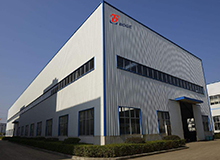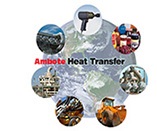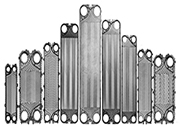Gasketed Plate Heat Exchanger

Principle
Plate heat exchangers have more than 100 years history and its structure is composed of a fixed frame, a movable frame and corrugated plates which are in between the two frames.Hot liquid and cold liquid go through between the corrugated plates in turn.To prevent leaking, gaskets are mounted around the plates and tightening bolts are used to put the plates together.There is heat transfer between the two liquids through the plates.This is the main principle of a plate heat exchanger.The arrangement of two liquids is that the cold liquid goes upward and hot liquid goes downwards in order to increase heat transfer efficiency.There is an advantage to use plate type heat exchangers over Shell & Tube type heat exchangers, that is to say, the corrugations in the plates reduces the liquid turbulence to a low Reynolds number and the liquids flow is counter current so that the heat transfer efficiency is always 3 ~ 5 times higher than Shell & Tube type heat exchangers.
Features
(1) High Heat Transfer Coefficients
BOGE Plate Heat Exchangers provide high rates of heat transfer, due to the turbulence inducing shape of the plates.
The special gasket configuration of the plates prevents any mixing of the media being processed.
In the port area both fluids are separated by double gaskets.
Additional safety is ensured by the leakage gap.
(2) Saving the installation space
Since the heat transfer efficiency is high, only 2-30% installation space is required comparing to the same capacity of the multi-tubular heat exchanger.
(3) Low contamination
Strong turbulent flow formed by the bump in flow way and short staying time of the fluid inside the heat exchanger will result in getting the effect to avoid scale adhesion. Convenient disassembling and assembling. Cleaning is easy to handle the contamination in an efficient way.
(4) Minimum heat loss
Heat is emitted in the side of the plate type heat exchanger and because the space is not much required the heat loss can be minimized due to less heat generation volume even when insulation or heat insulating materials are not used.
(5) Applicability & standardization
All the components or parts are standardized and the compatibility of the parts is good. Plate number can be increased or decreased depending on the change of the capacity. Cleaning or replacement is easy when the plate or gasket is worn out.
| Max. Operating Temperature | 180℃ |
|---|---|
| Max. Operating Pressure | 20kg/㎠ (for high pressure 50kg/㎠) |
| Plate Material | STS304, 304L, 316, 316L, 317, AVESTA, 254SMO, HASTELLOY-B, C, Titanium, Ti-Pd, NLCP(Nickel), AL-BRASS |
| Gasket Material | Nitrile(NBR), HNBR, HYPALON, BUTYL, FPM, FPM-G EPDM(Ethylene Propylene Diene Methylene), Silicone Neoprene |
| Frame Material | Carbon Steel, STS304, 316 |

 180 2027 5881
180 2027 5881







